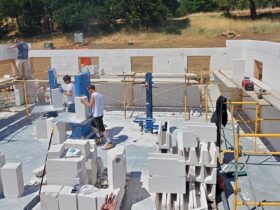These days, the construction industry is rapidly developing with the availability of modern technology. These days, most of the designs and plans of large structures are made on the computer, which helps to improve the effectiveness, safety, and speed of construction while keeping the costs low. Besides, the construction materials used now are also more lasting and robust than those used earlier. And this helps people to construct a more practical and safer structure with ease. Now formwork for concrete slab plays an important role in construction. Formwork is an indispensable structure that is often used permanently or temporarily for pouring concrete to build concrete slabs of different sizes. These formworks are constructed of sections like formwork panels, joists, stringers, shores, and other sustainable materials that allow to pour concrete and then to set the structure above the ground.
Types of formworks and importance of the formworks in construction:
Different formworks are used in construction to suit various purposes. Each of these formworks as the mould into that concrete is dispensed for the house slab. It then solidifies into the crafted shape. Here comes a list of the formworks and their uses in construction.
- Timber formwork: It is the most prominent example of traditional formwork used for years to construct concrete slabs. Earlier, this type of formwork was used widely because of the modest costs and easy availability. Constructed of plywood or lumber, this formwork is also very simple to craft. And the flexible nature of timber makes it perfect, even for complicated construction. But the only drawback of this formwork for concrete slab is that it has a shorter existence. So, it is not ideal for large structures.
- Concrete formwork: This is one of the most popular formworks used in the construction industry because of its ability to offer many benefits like low costs and low ecological footprint. This formwork is assembled on-site, and it also remains in the same place even after the concrete hardens. Another reason concrete formwork is often used to construct a house slabis that this can be built swiftly. And this type of formwork is also highly durable, resistant to fire, and offers great thermal and acoustic insulation. These are the reasons more and more countries are now using concrete formworks in their constructions of commercial and residential properties.
- Engineered formwork: This is one of the most widely used formworks that include preassembled modules made of metal frames using aluminium or steel. The best thing about this formwork for concrete slab is that can be reused many times. This thing makes it a popular and affordable option for different construction companies in Australia.
- Plywood formwork: This is another type of formwork that is gaining great popularity in the construction industry in recent time. This formwork offers a smooth surface, which needs no other finishing treatments. Besides, this formwork can also be used several times at a stretch. As plywood is often used to cover up a large area, therefore it often decreases the labour cost associated with dismantling or fixing formworks.





